| Visitors can click on
most of the photos
below to see larger
images and can click here to view
a nine-minute video that Helen produced.
The Des
Moines Register's Annual Great Bicycle Ride across Iowa (RAGBRAI)
went through Rolfe on July 23, 2007. I was there with
camera, starting on a county road northwest of Rolfe and ending in town.
|
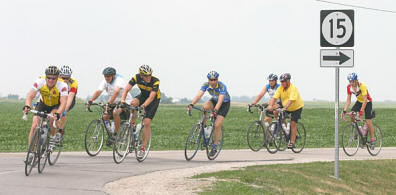 |
However, I regret not capturing more variety or
heading east where a farm couple,
Mike and Joni Behrendsen (RHS 1961 and circa 1969), served root
beer floats. It also would have
been great to photograph riders on the picturesque hills east of town
and crossing the Des Moines River. |
| I was not able edit the footage
until this week, because for most of the summer, I was fully engaged in
gardening at the home with large lot in Ames that I
acquired in 2006 .
You can click here
to access the nine-minute video. It is simple and in Windows
Media format.
The visual quality is
much inferior to that of seeing the program on a DVD. Soon there
will be DVD copies available to those who want them. Cost has yet to be determined. Drop
me a
note if you are interested in
getting one.
|
| There
is a section of the video that features my father, Deane Gunderson (RHS 1935),
with some of his family, friends, visitors, and an 11-foot-tall
statue of a red bird. The bird is a replica of Cy (the traditional mascot for Iowa
State University). Deane, who is a retired Rolfe area farmer, has
degrees in agricultural and mechanical engineering from Iowa State and made the steel statue in about 1975. From the late 1970s through the early 1990s, the
statue stood at the north end of the Iowa State football stadium.
Later it came to rest for several years, rusted with nary a hint of paint and scruffy,
in Deane's machine shed. However, with the help of his farm tenants,
Dan and Roger Allen (RHS circa 1967 and 1969) as well as Rod Bunda
of the Collision Center in Pocahontas, the statue was repaired and painted.
Then it was perched on Main Street in time for the RAGBRAI
festivities near the law office of Deane's son, Charles Gunderson (RHS
1962 , ISU, and the University of Iowa). The statue is still perched on Main Street.
Deane had a full day on
the 23rd, greeting RAGBRAI visitors, visiting with them about the
statue, and having his picture taken with them. I would
have been remiss if I did not focus a little attention on his 15
minutes of fame, but there was much more involved
in the Rolfe community hosting RAGBRAI that I did not catch on
camera. |
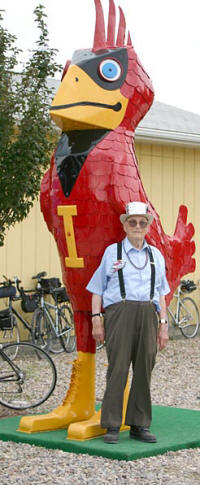 |
| A host of unsung
heroes made the day such a successful one. Someone
should write about the challenges, risks, and joys that are involved when a small town such as Rolfe hosts RAGBRAI.
|
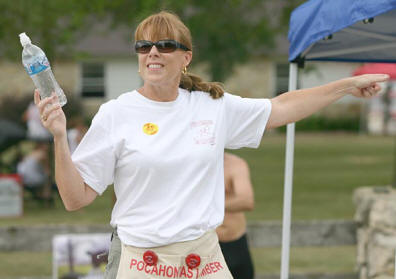 |
Just how many bottles of water did Mary Allen
(left) end up
with on her shelves? RAGBRAI was a good lesson in how "location is
everything" in marketing. Mary was stationed on the main highway in
front of her home, Bud Barn, and the world's largest Clydesdale
rocking horse, but a few blocks ahead of the main intersection. |
| When riders approached
a town, it appeared that many were focused on getting to the heart of the berg,
taking a quick scan of what was available before stopping for food,
water, and other amenities, then settling in for a sense of
community. Apparently Tom Hamm of Rolfe thawed out hundreds of
steaks for the day,
planning to cook and sell them to riders for an early dinner in Bradgate (the next town east of Rolfe). But he ended up having to either give or throw away
many leftover steaks because riders were eager to get to Humboldt, about another 15 miles
down the road, for their supper, entertainment, and night's rest. |
| In 1974, the second year of the event, I rode on RAGBRAI from Council Bluffs to Dubuque. An
estimated 1,700 riders
completed the trip compared to the 15,000 or so riders this year.
Of course a lot has changed. In 1974, there was no Internet with
sophisticated weather forecasting to prepare for a day's ride, nor email
at local libraries to keep in touch with folks back home, nor
cell phones to connect with other riders or call for emergency
help. And the bicycles were not as light then or otherwise as
technically advanced as they are now. |
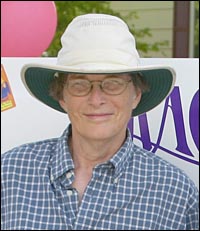 |
| This year, several bicyclists had small carts or other devices to carry boom boxes that blared music
into the country air. For the most part, the music was
an intrusion into the pastoral nature of the ride, and I was
particularly miffed when a few riders ambled obliviously along with their bikes in the
crowd in town with their music still blaring even though there was a
nearby area where local musicians were performing. I wanted to
holler, "Hey, you're rude." RAGBRAI in the early 70s seemed designed
for participation by the average rider. If there were people of
celebrity status in those early years, they were people such as
Donald Kaul and John
Karras of the Register, who started event. There was also a
celebrated octogenarian rider by the name of
Clarence Pickard.
I once took a photo of Clarence and his pith helmet. However, those people had a low-key
presence and were part of the fabric of the event. None of them was given
star status like Lance Armstrong who has ridden RAGBRAI in the last
two years. No one I talked to that day had seen
Lance. There was rumor that he had gone ahead, quietly in the early
morning.
I recall a little about the politics of the summer of 1974. In
one small town, the number of public toilets was extremely
limited, and I stood in a long line leading to the small rest room
of the only gas station in that town. The site of the bathroom was not pleasant,
and I was turned off by the instructions passed through the line that only
every fifth person should flush. I was getting desperate with the
call of nature and heard that a beauty shop in a nearby house had a restroom she
might be able to use. Sure enough, when I went and asked about
their facilities, the stylists were friendly and welcomed me to
use the bathroom at the back of the parlor. I had to meander
through the room where women were sitting in styling chairs in
front of the mirrors and under hairdryers. When I walked back
through the room, there was a 13-inch television set. I was
surprised to see that Gerald Ford was being sworn in as President to fill the vacancy
created when Richard Nixon left office. I sat down to watch and
appreciated
an excuse to linger and rest from the days ride. It is
probably best not to comment on the ethics of the current
president. But it was eerie, earlier this year, to see
the movie Sicko by Michael Moore about the nation's health
care system its archival footage from the Nixon
administration. Oh, those jowls, shifty eyes, and huge eye brows of
Richard Millhouse Nixon. It is hard to forget his saying,
"I am not a crook." I am not a fan of
rowdy, tailgating-type atmospheres nor large crowds nor camping with
thousands of other people nor eating fast food for many meals in a
row. Also, I do not
enjoy being on a bicycle for long hours for several days in a row.
I need more variety in my week, which means I have not been on RAGBRAI since 1974.
Yes, I have owned a couple of new bicycles during the past three
decades but had gotten away from serious biking. A few
years ago, I gave my perfectly good purple Bianca, ten-speed bicycle to the Friends of
Central Iowa Bicycling for their spring fundraiser so that it would
not sit around unused and continue to rust on my apartment deck. Then in 2006,
I purchased my home in Ames and bought a 1974 Raleigh, three-speed
bicycle via the Ames Tribune classified ads for $50. I had
no idea at the time how many people would covet the classic bike.
However, when I began looking for a used bicycle, I had talked
to Ron at Skunk River
Cycles who recommended a three or five-speed Raleigh for getting
around Ames.
Apparently, he has at least one classic Raleigh himself. I rode
my Raleigh some last fall and winter, then since April of 2007 have used it for 95 percent of
my in-town transportation. With snow and
temperatures dropping into the mid and low-20s today, it remains to
be seen how much longer I can extend my bike-riding this winter. But
on Thanksgiving Day, I did ride across town to the Unitarian-Universalist
Fellowship where I had
organized a potluck dinner. Last January was mild, and it was possible to ride a lot then. So
maybe something akin to that will happen again this year. I have
also cut back out-of-town travel and been able to reduce car mileage by about 700 miles per month.
I love the tactile and
social experience
of riding, the benefits to my physical and mental health, a sense
of being frugal in at least one dimension of life, the idea of
reducing carbon emissions, seeing Ames from new perspectives, and being one of the alternative
transportation fringe people in Ames. Hopefully, more people will
turn to bicycles for everyday transportation. The last time I
had been near RAGBRAI activities was in 1996, when I drove Dad to Sibley so he could participate in the day of RAGBRAI that
ended in Estherville.
I enjoyed being in the Rolfe area for this year's RAGBRAI and
was surprised to see so many out-of-town riders she knew. There
were:
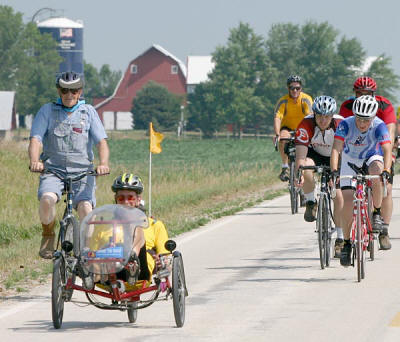 |
| |
Louie Hammer (left), an octogenarian farmer and
actor from Pocahontas riding in a chambray shirt, blue
cotton scarf, rolled up bib overalls, and
leather boots. |
|
|
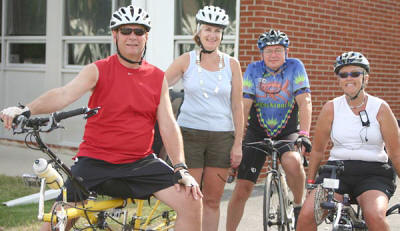 |
| |
Deb Penney (second from left), my dental hygienist in Ames. |
|
| |
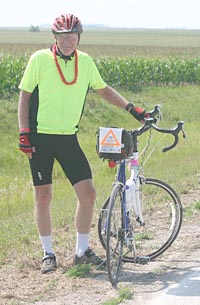 |
Warren Scholten (left), a retired special
education teacher from Eagle Grove, where I taught in
1974 and 1975. Jon Popp, mayor-elect of Gilbert, where
I lived for 13 years
before moving to Ames. Jon was appointed to fill the council
vacancy created when I resigned in 2002, and I have often
criticized Jon and his cronies in the Gilbert Gazette.
|
|
|
| But RAGBRAI is a time of goodwill, and I had not
seen Jon in a long time. That was both because my new focus
was on life in Ames and because I was trying to wean myself from
several years in which Gilbert government and the ways it
skirted Iowa's open meeting and records laws had been too much
on my brain.
As I stood in the middle of the
only stoplight intersection in Rolfe, a voice called my name. I turned, looked, and asked the man if I
knew him. He said he was Jon Popp. It is interesting how
different a person looks when dressed in bicycle gear and
out of ordinary context. We had a pleasant talk, and I felt
a sense of healing of the tensions that had existed between
myself and the Gilbert council.
I also saw Joyce and Julie Brinkman, RHS athletes from the late
1960s and early 1970s. Of course, there were plenty of other Rolfe
ex-patriots who rode on RAGBRAI and Rolfe people who worked
the event. But I am a late riser, and by starting my coverage northwest of Rolfe and not arriving in town until
early afternoon, I missed a lot of folk and activities.
There were also riders from far beyond the
borders of Iowa. In fact, it was a revelation, when I was at Skunk River Cycles in Ames the week ahead of RAGBRAI to get a cotter pin replaced, that people from
places such as California would ship their bicycles to Iowa
where a shop would assemble the bikes for the
riders to pick up when they flew into the state.
| |
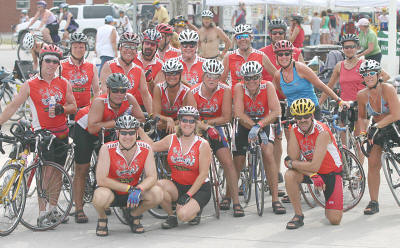 |
|
| |
There was an orange-clad clan from
California that assembled to let me photograph them near the Pronto
Station. Their shirts said "Dog Chow" and "20 years of the
06 Red Dog." |
|
| |
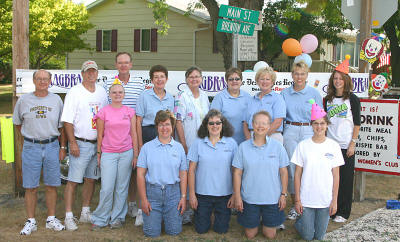 |
|
| |
Technically, I started the day
in Havelock, a small town northwest of Rolfe, where my friend, Carol Hallman of Pocahontas, had set up a
fund-raising booth with other members of the Pocahontas
Women's Club. (Carol is second
from the right in the front row.) |
|
| |
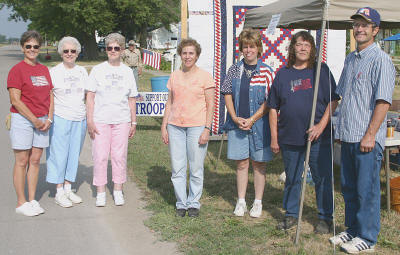 |
|
| |
While in Havelock, I also
met Betty Nielsen from Fonda and the Freedom Quilt group.
www.freedomquilts.net |
|
It would be
interesting the count the number of towns along an entire
RAGBRAI route and know the reactions of their leaders and
citizens to the ride coming through their space. How many of
them anticipated that RAGBRAI would put their communities on
the map and generate lots of income? How many were reluctant
to host RAGBRAI?
I heard many riders say things
such as, "These Iowa small towns are great places." RAGBRAI does bring out the best in
Iowa small town culture as evidenced by the civic groups in
Havelock and Rolfe that provided
thousands of riders with great hospitality. But out-of-state riders cannot truly fathom what a small
town is like based simply on a RAGBRAI visit. There are
economic and cultural issues in towns such as Havelock and
Rolfe. The two bergs are declining in population and
financial health and have lost their schools, sending their
students to Pocahontas. There are also environmental issues
with Iowa having some of the worst polluted rivers in the
nation, in large part due to modern agriculture.
Farmers are facing
dramatically increased costs of production inputs (seed,
herbicides, fertilizer, machinery, repair bills, diesel fuel
for row crop farmers), and the
industrialization of agriculture continues to put a
disproportionate share of revenue into corporate coffers.
Admittedly, corn and bean prices are at their highest in
decades, but it remains to be seen how much the increase in
those grain prices will keep ahead of the increased costs of
inputs. In other words, will there actually be an increase
in the profit margins for farmers—and will it be lasting or
a passing bubble? Even with Iowa's panacea of
producing Ethanol, an alternative fuel whose revenue that
some people think will enrich local communities, the power
of the Ethanol industry—for the most part—does not lie in
the hands of the locals. Instead, there is the risk as
decades go by that the small towns will become more like
Third World countries.
When cyclists ride by those
beautiful fields of corn and beans, they might have
nostalgia for what they think the rural scenery represents.
But it would be quite revealing for the cyclists to take
time to study spreadsheets—either of an individual farmer or
those published by Iowa State University Extension. The ISU
agricultural economics department has a chart that shows the
input costs for each year from 2003 to 2007, and the
department's preliminary estimates are that the costs will
increase at least another 15 percent for 2008.
PDF file of costs 2003-2007
agricultural economics web site
After the last bicyclists in the
multi-hour parade head
on to the next town, those issues continue to exist even
though there are plenty of leaders and other citizens doing
their doggonedness to have viable communities. I wouldn't mind visitors saying that the towns put on
great parties. But some visitors seem caught up in
a Camelot-type experience during the weeklong ride. They trivialize towns
by naively claiming them to be great places on the basis of
how they presented themselves for RAGBRAI.
| |
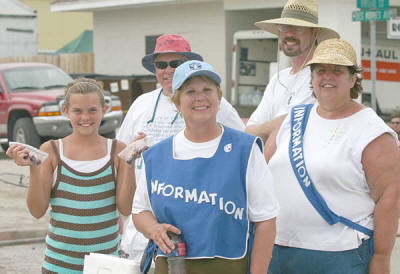 |
|
| |
Some of the Rolfe welcoming crew.
Front row, left to right: Hannah Maley, Beth Pearson, Gloria
Gunderson. Back row: Richard Taylor and Mike Majorowicz (RHS
1983). |
|
Rolfe did put on
a great party, and the Register and riders should thank
their lucky stars that towns such as Rolfe are willing to do
go to such great effort with so much risk to make RAGBRAI as popular as it is. latest update 11-26-2007
video clip
Visitors can click on most of
the photos above to see larger images.
 Return
to Essays Return
to Essays
|
|